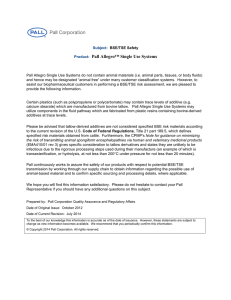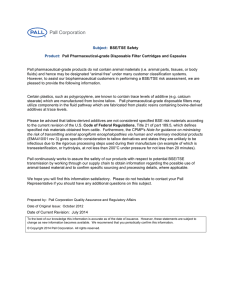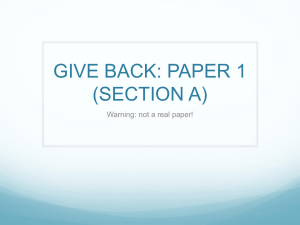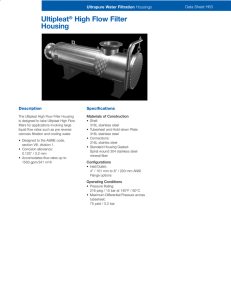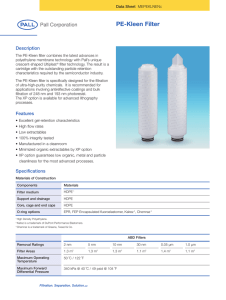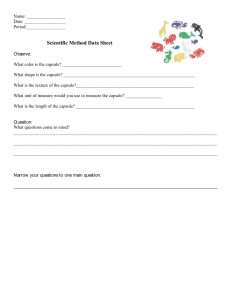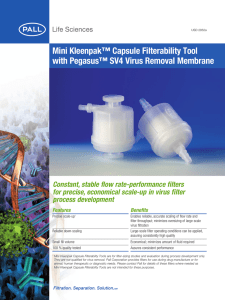Pall Minidisc Filter Capsules with Pegasus SV4 Virus Removal
advertisement
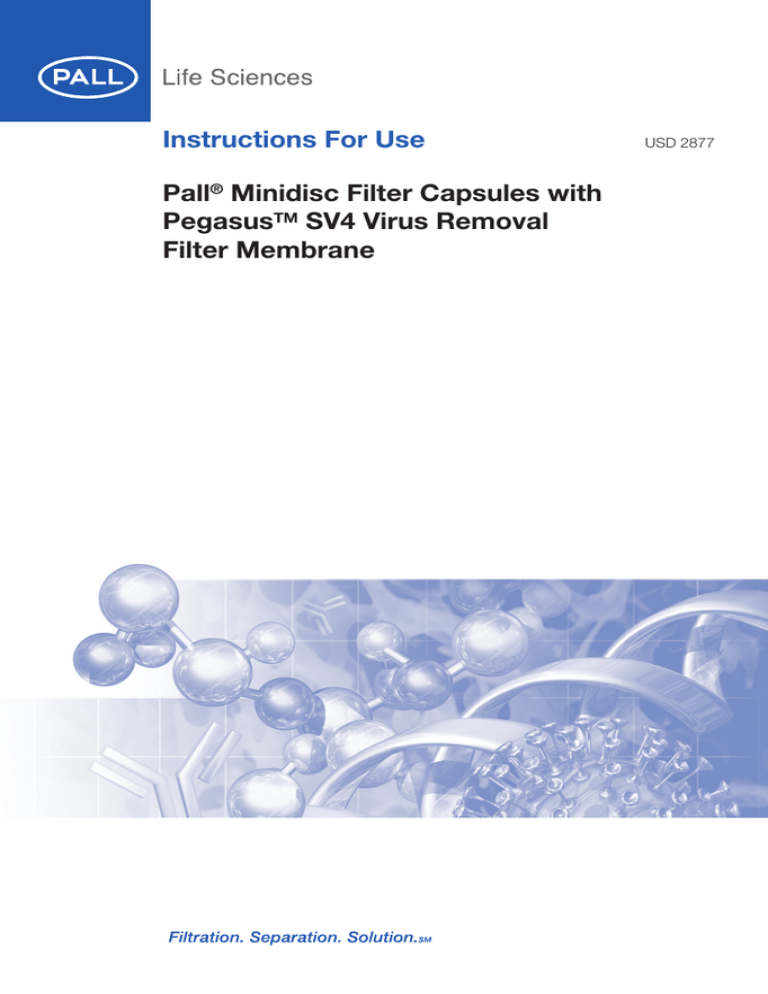
Instructions For Use Pall® Minidisc Filter Capsules with PegasusTM SV4 Virus Removal Filter Membrane USD 2877 1. Introduction The following guide details procedures for the assembly and testing of Pall Minidisc Filter Capsules with Pegasus SV4 Virus Removal Filter Membrane (part number 10MCFSV4). 2. Parts Required • Source that can supply air up to a pressure of 3.1 bar (45.0 psi) • Pressure gauges • Male and female Luer-Loku to tubing adaptors capable of withstanding 3.1 bar (45.0 psi) or the required test pressure • A 3-way Luer-Lok valve (2 x female Luer-Lok, 1 x male Luer-Lok) • Pressure vessel capable of operating at 3.1 bar (45.0 psi) Pall Pressure Vessels Pall Part Number NovasipTM vessel* Sealkleen vessel C3EP1 ZLK702G23LHKH4 Pressure Vessel Accesories Pall Part Number Adapter 1 in. TC/male Stäubli connector TC clamp + silicone gasket (two each per part number) GFX0290 (two recommended for inlet and outlet) SLK1TC23H4 Female Stäubli fitting for inlet pressure tubing (6 mm O.D.) GFX0236 * See Figure 1. • Graduated cylinder or collection vessel • Balance (optional) • Appropriate tubing capable of withstanding 3.1 bar (45.0 psi) or the required test pressure • Capsule to be tested 3. Assembly 1. Attach pipework with the male Luer-Lok to the downstream side of the pressure vessel. 2. Connect the inlet of the capsule to the 3-way Luer-Lok valve. 3. Connect the valve to the pressure vessel via the male Luer-Lok. 4. Ensure that the unconnected female Luer port is shut off by the valve. 5. Insert and hold the capsule so that the outlet of the filter points upward (Figure 2: Recommended Wetting Procedure). 6. Fill the pressure vessel with clean de-ionized (DI) water to at least the minimum fill volume specified in Table 1. 2 USD 2877 Figure 1 Filterability and Challenge Test Setup Pressure Source Pressure Vessel (Novasip) Temporary Waste Line Tubing 3-way Luer-Lok Valve Minidisc Test Capsule Filtrate Samples 4. Pre-Challenge Wetting 1. Ensure that the capsule remains inverted as per Section 3.5 (Figure 2: Recommended Wetting Procedure). 2. Adjust the air pressure to the pressure vessel containing water to the approximate wetting pressure specified (see Table 1). Admit DI water (or similar grade) into the inlet of the capsule until water begins to come out of the outlet. Do this slowly to ensure that there is no air trapped upstream of the filter membrane. 3. Once water starts to come through the outlet, wetting is complete. Return the capsule to its original position with the outlet facing down (see Figure 3). Figure 2 Recommended Wetting Procedure USD 2877 www.pall.com/biopharm 3 Figure 3 Return the capsule to its original position Table 1 Pre-Challenge Wetting Parameters Capsule Minimum Fill Volume of Water Approximate Wetting Pressure Typical Wetting Time 10MCFSV4 40 mL 2.1 bar (30 psi) < 2 minutes 5. Pre-Challenge Installation Test 1. Adjust the water pressure to the value specified in Table 2: Pre-Challenge Installation Test Parameters. 2. Once the flow is steady, collect the filtrate using a graduated cylinder or balance for the water flow collection time specified in Table 2: Pre-Challenge Installation Test Parameters. 3. Calculate and record the flow rate. Due to variation in the viscosity of water at different temperatures, it is recommended that all water flow rates are normalized to an equivalent value at 20 °C. The following equation should be used in conjunction with the temperature correction factor (TCF) at the test temperature (T °C) from Table 3. Water Flow Rate 20 °C = Water Flow Rate T °C x TCFT °C 4. If the normalized water flow rate of the capsule does not meet the water flow rate in Table 2 check all parameters and repeat the test. If the water flow is still outside the range shown in Table 2 please contact your local Pall representative. 5. Raise the water pressure to 3.1 bar (45.0 psi) and check for leaks. If any leaks are evident: (a) Tighten the tubing connections. (b) If the leak persists, replace the tubing and check for any gross leaks. (c) If this does not resolve the problem, record any leaks and use another filter sample. Warning: Do not allow air to enter the upstream of the capsule. 4 USD 2877 Table 2 Pre-Challenge Installation Test Parameters Capsule Pressure Water Flow Collection Time Water Flow Rate mL/min at 20 oC 10MCFSV4 2.1 bar (30 psi) ≥ 10 minutes 0.48 – 0.7 These data are solely valid for Minidisc capsules with Virus Removal Filter Membrane, which are supplied by Pall for filterability trials and virus validation studies respectively, for the purpose of down-scaling. Table 3 Temperature Correction Factors (TCF) for Normalizing Water Flow Rates to 20 °C Temperature Correction Factor (TCFT °C) at Various Temperatures (T °C) T °C 4 5 6 7 8 9 10 TCFT °C T °C TCFT °C T °C TCFT °C T °C TCFT °C 1.57 1.52 1.47 1.43 1.39 1.35 1.31 11 12 13 14 15 16 17 18 19 20 1.27 1.24 1.20 1.17 1.14 1.11 1.08 1.05 1.03 1.00 21 22 23 24 25 26 27 28 29 30 0.98 0.95 0.93 0.91 0.89 0.87 0.85 0.83 0.81 0.80 31 32 33 34 35 36 37 38 39 40 0.78 0.76 0.75 0.73 0.72 0.70 0.69 0.68 0.66 0.65 6. Filterability/Viral Challenge Test Procedure 1. Once the pre-challenge wetting procedure has been completed (Section 4: Pre-Challenge Wetting), remove the remaining water from the reservoir and from the tubing upstream of the capsule. Warning: Do not allow air to enter the upstream of the capsule. (a) Connect a piece of tubing with a male Luer-Lok connector to the free valve port to give a waste line. Place the free end of the waste line in an appropriate collection vessel. (b) Turn off the valve port to the capsule inlet, opening up flow from the pressure vessel to the waste line. (c) Adjust the pressure in the pressure vessel to approximately 0.2 bar (3 psi) and drain all the water from the pressure vessel and tubing. (d) Depressurize the system. (e) Turn off the valve port to the waste line. 2. Fill the pressure vessel with the test fluid. USD 2877 www.pall.com/biopharm 5 3. Bleed the remaining air from the tubing. (a) Turn off the valve port to the capsule inlet. (b) Once the air is bled from the tubing and test fluid starts to exit the waste line, turn off the valve port to the waste line. (c) Disconnect the waste line, taking care not to spill residual fluid in the tube. 4. Adjust the pressure in the pressure vessel containing the test fluid to 2.1 bar (30.0 psi) — or to another operating pressure (maximum 3.1 bar (45.0 psi) — and run the challenge until the desired volume is collected. 5. Effluent may be collected in 20 mL aliquots or in another convenient volume. 6. Record the time, pressure, temperature and throughput as required. 7. Post-Challenge Installation Test 1. The post-challenge installation test is recommended for all virus challenge studies and is optional for all other studies. 2. Connect the challenged capsule directly to the air source and increase the pressure to 3.1 bar (45.0 psi). 3. Hold the system as recommended for about 5 minutes or until no liquid comes out of the filter. The upstream of the capsule should now be drained of all liquid. 4. Hold the open end of the outlet tubing under water, with the capsule outlet pointing up, for about 30 seconds and check for any bubbles emerging from the tubing. The absence of bubbles indicates an integral system. Only a continuous stream of bubbles is significant. One or two isolated bubbles in 30 seconds may be a false signal due to trapped air in the lines. 8. Scaling Calculation Table 4 Scaling Calculation Capsule 47 mm disc (used with FTK200) Minidisc Capsule 10 in. cartridges Effective Filter Area (m2) Effective Filter Area (m2) Effective Filter Area (m2) 10MCFSV4 1.11 x 10-3 9.6 x 10-4 2.25 9. Specifications 9.1 Viral (Bacteriophage) Retention Refer to the Validation Guide for the corresponding virus removal filter grade. 9.2 Packaging Box containing 3 filter capsules. 9.3 USP Bacterial Endotoxins Pall Minidisc Filter Capsules have met the current USP requirements under Section <85> Bacterial Endotoxins Test as determined using the Limulus Amebocyte Lysate (LAL) reagent with an aliquot from a soak solution. 9.4 Materials Minidisc virus filter fluid path components have met the specifications under Section <88> Biological Reactivity Tests, in vivo, listed in the current revision of the United States Pharmacopeia (USP) for Class VI plastics at 121 °C. 6 USD 2877 Table 5 Materials of Construction Materials of Construction Membrane Virus-retentive Membrane (Refer to capsule label for filter membrane grade) Support disc O-ring Capsule Inlet and Outlet Connection Filter Area Wetting Installation Test Polypropylene (Non-woven) EPDM Polycarbonate Luer-Loku 9.6 cm2 (1.49 in2.) Refer to Section 4: Pre-Challenge Wetting Refer to Sections 4 and 7 Table 6 Pressure Rating Pressure Rating* Maximum operating pressure Maximum differential pressure 3.1 barg (45.0 psig) at 25 °C 3.1 bard (45.0 psid) at 25 °C * Temporary pressures up to 3.4 barg (50 psig) are acceptable, but the target operating and differential pressures should not exceed 3.1 bar (45 psi) to allow for pressure fluctuations during testing. Technical Addendum for ATEX 94/9/EC Pall Encapsulated Filter Assemblies Installation and maintenance should be undertaken by a competent person. National and local codes of practice, environmental regulations and Health and Safety directives must be adhered to and take precedence over any stated or implied practices within this document. For fluids having low conductivity, there exist the possibility of the generation of static electricity during use with polymeric components. This could potentially lead to a static electricity discharge resulting in the ignition of a potentially explosive atmosphere where such an atmosphere is present. These Pall products are not suitable for use with such low conductivity fluids in an environment that includes flammable liquids or a potentially explosive atmosphere. Where flammable or reactive fluids are being processed through a Pall capsule assembly, the user should ensure that spillages during filling, venting, depressurizing, draining and capsule change operations are minimized, contained or directed to a safe area. In particular, the user should ensure that flammable fluids are not exposed to surfaces at a temperature that may ignite the fluid, and that reactive fluids cannot contact incompatible materials that may lead to reactions generating heat, flame or that are otherwise undesirable. Pall capsule assemblies do not generate heat, but during the processing of high temperature fluids, including steam sterilization operations and process upset conditions, it will take on the temperature of the fluid being processed. The user should ensure that this temperature is acceptable for the area in which the filter is to be operated, or that suitable protective measures are employed. When processing flammable fluids, the user should ensure that any air is fully purged from within the assembly during filling and subsequent operation to prevent the formation of a potentially flammable or explosive vapor/air mixture inside the equipment. This can be achieved through careful venting of the assembly or system as detailed in the user instructions. USD 2877 www.pall.com/biopharm 7 To prevent damage or degradation which may result in leakage of fluids from this equipment it is imperative that the end user check the suitability of all materials of construction (including seals on the connections where appropriate) with the process fluid and conditions. The user should ensure that the assembly is regularly inspected for damage and leaks, which should be promptly corrected, and that seals (where appropriate) are renewed after every capsule change. Leakage of flammable or reactive fluids from this assembly, arising through incorrect installation or damage to the equipment (including any seals), may generate a source of ignition if flammable fluids are exposed to a heated surface, or if reactive fluids contact incompatible materials that may lead to reactions generating heat, flame or that are otherwise undesirable. The user should ensure that the assembly is regularly inspected for damage and leaks, which should be promptly corrected, and that any seals are renewed after every filter change. The user should ensure that these products are protected from foreseeable mechanical damage that might cause such leakage, including impact and abrasion. Should you have any questions, please contact your local Pall office or distributor. Visit us on the Web at www.com/biopharm E-mail us at biopharm@pall.com Corporate Headquarters Port Washington, NY, USA +1.800.717.7255 toll free (USA) +1.516.484.5400 phone biopharm@pall.com e-mail European Headquarters Fribourg, Switzerland +41 (0)26 350 53 00 phone LifeSciences.EU@pall.com e-mail Asia-Pacific Headquarters Singapore +65 6389 6500 phone sgcustomerservice@pall.com e-mail International Offices Pall Corporation has offices and plants throughout the world in locations such as: Argentina, Australia, Austria, Belgium, Brazil, Canada, China, France, Germany, India, Indonesia, Ireland, Italy, Japan, Korea, Malaysia, Mexico, the Netherlands, New Zealand, Norway, Poland, Puerto Rico, Russia, Singapore, South Africa, Spain, Sweden, Switzerland, Taiwan, Thailand, the United Kingdom, the United States, and Venezuela. Distributors in all major industrial areas of the world. To locate the Pall office or distributor nearest you, visit www.pall.com/contact. The information provided in this literature was reviewed for accuracy at the time of publication. Product data may be subject to change without notice. For current information consult your local Pall distributor or contact Pall directly. © 2012, Pall Corporation. Pall, and Pegasus are trademarks of Pall Corporation. uStäubli is a trademark of Stäubli. Luer-lok is a trademark of Becton-Dickinson. ® indicates a trademark registered in the USA and TM indicates a common law trademark. Filtration. Separation. Solution. and UpScale are service marks of Pall Corporation. 11/12, PDF, GN11.4189 USD 2877
